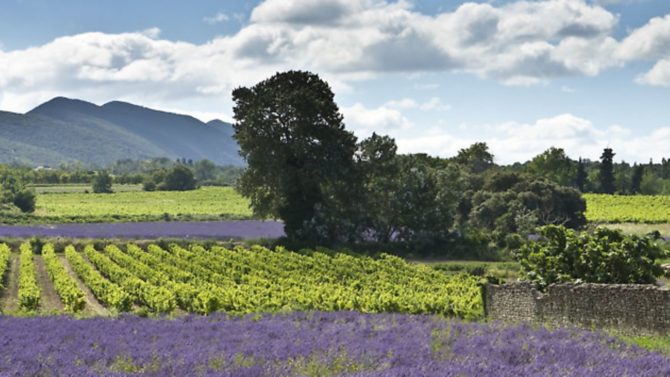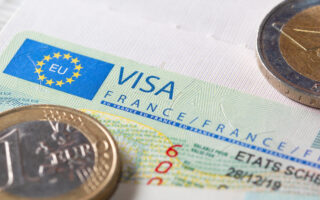Exploring Drôme

With fragrant lavender fields and lush scenery, delicious produce and pretty villages, Drôme is a great option for anyone longing for the south of France, says Emma Rawle

Sandwiched between the popular tourist areas of the Alps to the north and Provence to the south, the department of Drôme in the south of Rhône-Alpes is often described as Provence before the tourists arrived (and without the large price tag). Indeed, travelling through its colourful lavender fields, sun-drenched olive groves, world-famous vineyards and authentic, relatively touristfree villages, it certainly felt like the Provence of legend. What’s not to love?
As with much of France, Drôme is a department defined by its natural landscape, with the picturesque mountains of the Vercors dominating the east, the River Rhône running the length of the western border and the River Isère bisecting the department.
Drôme can be broadly divided into five distinct areas: Drôme des Collines to the north; the flat plains around the departmental capital Valence; the spectacular mountains of Vercors; the valley of the River Drôme; and finally, to the south, Drôme Provençale.

Many visitors, including me, arrive in Drôme via the airport at Lyon, meaning the first area they experience is Drôme des Collines and the impressive – if more than a little bizarre – Palais Idéal du Facteur Cheval in the small town of Hauterives on the department’s northern border. Built over 33 years, the palace was created entirely from the imagination of one man, local postman Ferdinand Cheval. He built the intricate structure largely single-handedly with stones collected on his post round and transported to the site in his wheel barrow. The palace is worth a detour, if only to marvel at the dedication of one man.
From Hauterives it is a 30-minute drive to the bustling town of Romans-sur-Isère, situated on the banks of the River Isère and home to more than 33,000 people. Famous for its shoe industry, the town has an entire museum dedicated to the history of shoes – Musée International de la Chaussure – and a busy shopping district with more than its fair share of shoe shops. The town’s other famous export is raviole, smaller than their Italian cousins and often filled with cheese and served with butter. I tried these delights on more than one occasion – all in the name of research obviously! Another delicacy to indulge in while in the department is Picodon, a small, round goat’s cheese, awarded AOC status and made in Drôme and neighbouring Ardèche. Drôme, as with much of France, is certainly a food-lover’s paradise.
A sizable town, Romans is full of life and I was lucky enough to arrive in the middle of the Festival International de Folklore, which happens every July, with live performances taking place in the town squares and stalls selling local produce. The town also boasts a well-preserved historic centre leading down to the river which is a great place to find somewhere for dinner and watch the sun set over the Pont Vieux.

From Romans, the next logical stop on the tour of Drôme is Valence, departmental capital and a lively student town. Described by my guide from the tourist office as a ‘human town’, Valence has managed to retain a friendly feel, and, despite its ample population, I am assured a local can always be confident in finding a friend or acquaintance to chat to in one of the café squares.
For those wishing to experience some culture, the recently re-opened Musée de Valence Art et Archéologie showcases Roman mosaics and remains, alongside paintings by British artists Gainsborough and Turner temporarily on loan from the Louvre. Even if art isn’t really your thing, the museum is worth a visit for the spectacular view of Valence from the roof terrace alone.
The town has plenty to offer outdoorsy types too, with paths along the River Rhône and the canals for a gentle stroll and the nearby Vercors mountains for a more vigorous hike. Part of the Viarhôna green lane that connects Lake Geneva to the Mediterranean runs along the Rhône in Valence, meaning walkers and cyclists can enjoy the river path without worrying about cars.

If all that fresh air has made you hungry then you are in luck because Valence boasts three Michelin-starred restaurants, including Maison Pic run by Anne-Sophie Pic, France’s only female chef to hold three Michelin stars. If a picnic in the park is more your thing then stop off at Maison Nivon to pick up some speciality breads – including the suisse de Valence, allegedly created in the image of the Vatican Swiss Guard in homage to Pope Pius VI who died in the town in 1799 – and head over to the Esplanade Champs de Mars, which is home to the iconic bandstand made famous by Raymond Peynet’s painting of two lovers.
From Valence, turn east and you discover a dramatically different landscape as the flat plains around the capital give way to sinuous mountain roads and deep valleys. For an unrivalled view of the Drôme valley and the Vercors hills, climb to the top of the Tour de Crest in the medieval town of the same name. Visitors can climb to the roof of the 52m keep for a spectacular view and, if feeling brave and having booked in advance, there’s an option to abseil down the side of the stone building – needless to say I opted for the stairs!
A fertile area, the Drôme valley is home to the AOC sparkling wine Clariette de Die and also Crémant de Die. A bottle can be picked up for around €8, and a tour and tasting at one of the many caves in Die, such as Jaillance, reveals the controlled fermentation process that produces the sparkling delicacy.

These aren’t the only wines that Drôme is famous for. As part of the Côtes du Rhône appellation, the department has an abundance on offer, from the powerful reds of Tainl’Hermitage in the north to the fresh rosés of Grignan-lesAdhémar in the south and everything in between. If you fancy learning a bit more about the wines then book onto a course at the wine university housed in the impressive Château Suze-la-Rousse where you can learn about the different wines of the Rhône Valley and discover how to taste wines like the professionals.
As well as wines, Drôme counts truffles, chestnuts and mushrooms among its produce. I was lucky enough to try all of these in a delicious home-cooked meal at Domaine d’Hermarie in the village of Rochebaudin, my lodgings for the night run by Marie-Jo and her husband Hervé who just happens to be a chef. All the dishes were home-made, from the cherry liquor apéritif to the apricot sorbet dessert, created from ingredients sourced locally.
Leaving the valley and heading south, the landscape of mountains and greenery gradually gives way to fields of fragrant purple lavender, vineyards and olive trees indicating entry into the area known as Drôme Provençale. Feeling much more like Provence than the other parts of Drôme, this area is home to pretty medieval villages and glorious sunshine and, as a result, is the place many tourists and expats make a beeline for.

One of those expats is David Hall, who, along with his wife Janet, bought and renovated a farmhouse near La Bégude-de-Mazenc as a second home 26 years ago. In 2003, they moved permanently to Drôme Provençale to run a gîte and haven’t looked back since.
“We chose to buy our holiday home here because we wanted rural space and good weather at a price we could afford and not more than eight hours’ drive from Calais,” explains David. “It continues to meet all these criteria and many more: lovely people, food and wine, good quality roads that are empty barring July and August… I live the dream.”
David and Janet live near Dieulefit – literally translated as ‘God made it’ – a pretty village set among the green and purple landscape that welcomes holidaymakers in the summer. Yet the village hasn’t lost its charm, with a pedestrianised main street lined with potters’ workshops and ceramic shops, medieval churches and attractive stone houses. Dieulefit is famous for its potters so don’t go home without buying some authentic Dieulefit ceramics to take with you.

Another southern Drôme village worth a visit is the Plus Beau Village of La Garde-Adhémar, perched high on a hill not too far from Montélimar, home of the sweet nougat Drôme is famous for. Offering uninterrupted views of the Rhône Valley, this pretty village is surrounded by a high defensive wall, largely intact, and is the perfect place to while away a few hours in either one of the cafés on the square or in the peaceful and fragrant Jardin des Herbes.
Further south, on the border with Vaucluse, sits the town of Nyons, where black Tanche olives are grown and pressed to make AOC olive oil. The most northern place olives are grown, Nyons enjoys a Mediterranean microclimate with plenty of sunshine and fewer of the storms that frequent the mountain villages. Nyons is definitely a gourmet destination and visitors can discover the secrets of olive production at the Vignolis Coopérative du Nyonsais, which has an informative museum and well-stocked shop selling all varieties of olive conceivable, including tapenade, olive oil and the iconic black olives.
On the other side of town is the Vinaigrerie La Para, a one-man operation creating vinegar from local wine in numerous flavours from lavender to chilli. Next to the vinaigrerieis the Distillerie Bleu Provence where lavender from the local fields is transformed into essential oils and beauty products, and used to flavour teas, chocolates and macarons.

As you might expect property prices are higher here in Drôme Provençale than in the rest of Drôme. The average house price in the area around Nyons is €198,000 compared to a departmental average of €185,000 and an average of €150,000 for the area around Die. However, this is still considerably cheaper than neighbouring Vaucluse, with an average of €213,000, and Provence-Alpes-Côte d’Azur with an average of €290,000.
So, next time you’re thinking of holidaying or househunting in the south of France, pay Drôme a visit; it won’t be long before you’re hooked.
Drôme tourist board: www.ladrometourisme.com
Not quite the place for you? How about neighbouring Ardèche or the Lot Valley
Share to: Facebook Twitter LinkedIn Email


